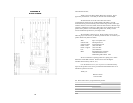
APPENDIX A
SPECIFICATIONS
Transmission Format: Asynchronous
External Interface: RS-232C/CCITT V.24 connection via DB-25
female; EIA/TIA-561 connection via RJ-45 (10 wire); twisted pair
connection via RJ-11 or RJ-45 (8 wire)
Internal Interface: Connection to Model 1000R16 rack chassis via 50
pin male card edge
Transmission Line: 4-wire, unconditioned twisted pair, 19-26 AWG,
20pf/ft or better
Data Rates: 0 - 57.6 Kbps
Controls: Carrier constantly "ON" or "controlled by RTS"
Applications: Point-to-point or multi-point
Indicators: Bi-level LED indicators (two each) for Transmit Data,
Receive Data, Control In and Control Out; bi-level indicators (one
each) for Power and Test
Diagnostics: Local and remote analog loopback, activated by front
panel push button
Receiver Optical Isolation: 150V AC
Surge Protection: Silicon Avalanche Diodes, 600 watts RMS power
dissipation @ 1 ms, with response time of less than 1 pS
Power Supply: Rack-mount power supply is switchable between 120V
and 240V AC; rack chassis supplies 10V AC to the Model
1060RC, typical Model 1060RC consumption is 700 mW
Fuse: 400 mA for 120V applications; 200 mA for 240V applications
Temperature: 0-50
°
C / 32-122
°
F
Humidity: 0-95%, non-condensing
Dimensions: 0.95"h x 3.1"w x 5.4"l
APPENDIX B
CABLE RECOMMENDATIONS
The Patton Model 1060RC operates at frequencies of 100kHz or
less and has been performance tested by Patton technicians using
twisted-pair cable with the following characteristics:
W
ire Gauge Capacitance Resistance
19 AWG 83nf/mi or 15.72 pf/ft. .0163W/ft.
22 AWG 83nf/mi or 15.72 pf/ft. .0326W/ft.
24 AWG 83nf/mi or 15.72 pf/ft. .05165W/ft.
Using or simulating cable with the above characteristics, the
following data rate/distance results were obtained by Patton during
bench tests:
Data Rate (Bps)
Gauge (AWG) / Distance (Mi)
19 22 24
57,600 2.5 1.8 1.3
38,400 3.7 2.3 1.7
19,200 5.1 3.4 2.4
9,600 6.7 4.6 3.7
4,800 9.4 6.6 5.3
2,400 11.5 9.3 7.6
1,200 14.0 12.0 9.6
To gain optimum performance from the 1060RC, please keep the
following guidelines in mind:
•
Always
use twisted pair wire—this is not an option.
• Use twisted pair wire with a capacitance of 20pf/ft or less.
• Avoid twisted pair wire thinner than 26 AWG (i.e. avoid higher
AWG numbers than 26).
• Use of twisted pair with a resistance greater than the above
specifications may cause a reduction in maximum distance
obtainable. Functionality should not be affected.
• Environmental factors too numerous to mention can affect the
maximum distances obtainable at a particular site. Use the above
data rate/distance table as a
general guideline only.
19 20


















